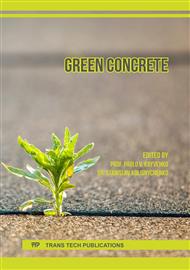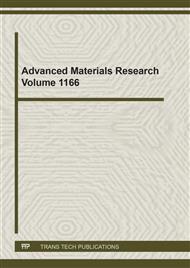[1]
Information on https://www.who.int/news-room/air-pollution#:~:text=Air%20pollution%20levels%20remain%20dangerously,from%20exposure%20to%20polluted%20air. [accessed on 16 February 2021].
Google Scholar
[2]
Information on https://worldgbc.org/clean-air-buildings/impacts. [accessed on 16 February 2021].
Google Scholar
[3]
Information on https://www.nationalgeographic.com/environment/global-warming/greenhousegases/#:~:text=Greenhouse%20gases%20have%20far%2Dranging,change%20caused%20by%20greenhouse%20gases. [accessed on 16 February 2021].
Google Scholar
[4]
R. Kajaste, M. Hurme, Cement industry greenhouse gas emissions – management options and abatement cost, J. Clean. Prod. 112 (2016) 4041-4052.
DOI: 10.1016/j.jclepro.2015.07.055
Google Scholar
[5]
A. Naqi, G. Jang, Recent progress in green cement technology utilizing low-carbon emission fuels and raw materials: a review, Sustainability. 11(2) (2019) 537.
DOI: 10.3390/su11020537
Google Scholar
[6]
A. Petek Gursel, E. Masanet, A. Horvath, A. Stadel, Life-cycle inventory analysis of concrete production: A critical review, Cem. Concr. Compos. 51 (2014) 38-48.
DOI: 10.1016/j.cemconcomp.2014.03.005
Google Scholar
[7]
Information on https://www.astm.org/Standard/interests/cement-and-concrete-standards [accessed on 16 February 2021].
Google Scholar
[8]
American Society for Testing and Materials (ASTM International), Standard terminology related to concrete and concrete aggregates. Active Standard ASTM C125 -20 (2021) 2-4. Pennsylvania. United States.
Google Scholar
[9]
American Society for Testing and Materials (ASTM International), Standard specification for concrete aggregates. Active Standard ASTM C33/C33M-18. (2021) Pennsylvania. United States.
Google Scholar
[10]
Information on https://theconstructor.org/concrete/ [accessed on 16 February 2021].
Google Scholar
[11]
B. Chattopadhyay, Portland Cement, in: M. S. Liew, P. Nguyen-Tri, T. A. Nguyen, S. Kakooei (Eds.), Micro and Nano Technologies, Smart Nanoconcretes and Cement-Based Materials, Elsevier, 2020, pp.461-483.
DOI: 10.1016/b978-0-12-817854-6.00001-5
Google Scholar
[12]
BSI (British Standards Institution) Standards Publications, Cement, Part 1: Composition, specifications and conformity criteria for common cements, BS EN 197-1:2011. Incorporating corrigenda November 2011, October 2015 and February 2019 (2019) 9-10. London. U.K.
Google Scholar
[13]
Aïtcin P.-C., 3 - Portland cement, in: Aïtcin P.-C., & Flatt R. (Eds.), Science and Technology of Concrete Admixtures, Woodhead Publishing, 2016, 27-51.
DOI: 10.1016/b978-0-08-100693-1.00003-5
Google Scholar
[14]
Van Oss, H.G., Padovani, A.C., Cement manufacture and the environment, Part II: Environmental challenges and opportunities, J. Ind. Ecol. 7(1) (2003) 93–126.
DOI: 10.1162/108819803766729212
Google Scholar
[15]
BSI (British Standards Institution) Standards Publications, Environmental management for concrete and concrete structures – Part 8: environmental labels and declarations, BS ISO 13315-8:2019 (E) (2019) 5-12. London. U.K.
Google Scholar
[16]
Information on https://www.cement.org/cement-concrete/how-concrete-is-made [accessed on 3 April 2021].
Google Scholar
[17]
H. Naderpour, M. Mirrashid, Estimating the compressive strength of eco-friendly concrete incorporating recycled coarse aggregate using neuro-fuzzy approach, J. Clean. Prod. 265 (2020) 121886.
DOI: 10.1016/j.jclepro.2020.121886
Google Scholar
[18]
Information on https://www.ccaa.com.au/imis_prod/documents/Library%20Documents/ CCAA%20Reports/RecycledWater.pdf [accessed on 15 May 2021].
Google Scholar
[19]
American Society for Testing and Materials (ASTM International), Standard specification for slag cement for use in concrete and mortars. Active Standard ASTM C989/C989M -18a. (2021) Pennsylvania. United States.
DOI: 10.14359/51663250
Google Scholar
[20]
American Society for Testing and Materials (ASTM International), Standard specification for coal fly ash and raw or calcined natural pozzolan for use in concrete. Active Standard ASTM C618 - 19. (2019) Pennsylvania. United States.
DOI: 10.1520/c0618-00
Google Scholar
[21]
American Society for Testing and Materials (ASTM International), Standard specification for silica fume used in cementitious mixtures. Active Standard ASTM C1240-20. (2020) Pennsylvania. United States.
Google Scholar
[22]
R.B. Holland, K.E. Kurtis, L.F. Kahn, Supplementary cementitious material in waste and in Concrete, 7-Effect of different concrete materials on the corrosion of the embedded reinforcing steel, in: A. Poursaee (Eds.), Corrosion of Steel in Concrete Structures, Woodhead Publishing, 2016, pp.131-147.
DOI: 10.1016/b978-1-78242-381-2.00007-9
Google Scholar
[23]
K.M. Liew, A.O. Sojobi, L.W. Zhang, Review - Green concrete: prospects and challenges, Constr. Build. Mater. 156 (2017) 1063-1095.
Google Scholar
[24]
O. A. Cuzman, L. Wittig, F. J. Royo Abancéns, C. Herrera, N. R. Anastasi, and L. Sánchez Alonso, Bacterial masons, at workwith wastes for producing eco-cement, International Journal of Environmental Science and Development. 6 (10) (2015) 767.
DOI: 10.7763/ijesd.2015.v6.696
Google Scholar
[25]
K. Yu, W. McGee, T.Y. Ng, H. Zhu, V.C. Li, 3D-printable engineered cementitious composites (3DP-ECC): Fresh and hardened properties, Cem. and Concr. Res. 143 (2021) 106388.
DOI: 10.1016/j.cemconres.2021.106388
Google Scholar
[26]
Information on https://www.italcementi.it/it/txactive-principio-attivo [accessed on 15 May 2021].
Google Scholar
[27]
GPI Global Product Innovation - HeidelbergCement Group, Photocatalytic communication kit: The role of photocatalytic cement-based products as sustainable solutions. Bergamo, (2020).
Google Scholar
[28]
L. Yang, A. Hakki, F. Wang, D. Macphee, Photocatalyst efficiencies in concrete technology: The effect of photocatalyst placement. Appl. Catal. B-Environ., 222 (2018) 200-208.
DOI: 10.1016/j.apcatb.2017.10.013
Google Scholar
[29]
M. Wimala, A. Fujiki, K. Kawai, Environmental impact of waste concrete treatment in precast concrete production, Conference Paper, Japan, (2011).
Google Scholar
[30]
M.J. McCarthy, T.D. Dyer, Pozzolanas and pozzolanic materials, in: P. Hewlett, M. Liska (Eds), Lea's Chemistry of Cement and Concrete, fifth ed., Butterworth-Heinemann, 2019, pp.363-467.
DOI: 10.1016/b978-0-08-100773-0.00009-5
Google Scholar
[31]
A. Tsiligiannis, C. Tsiliyannis, Renewable energy in cement manufacturing: A quantitative assessment of energy and environmental efficiency of food residue biofuels. Renew. Sustainable Energy Rev. 107 (2019) 568-586.
DOI: 10.1016/j.rser.2019.03.009
Google Scholar
[32]
Z. Xiaoyi, W. Dongling, Z. Yuming, K. B. Manokaran, A. Benny Antony, IoT driven framework based efficient green energy management in smart cities using multi-objective distributed dispatching algorithm. Environ. Impact Assess. Rev. 88 (2021) 106567.
DOI: 10.1016/j.eiar.2021.106567
Google Scholar



